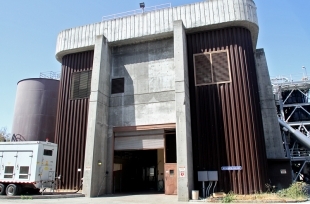Seeking to shed Palo Alto's status as one of only two California cities that still burn their sludge, the City Council swiftly approved early Tuesday morning the construction of a nearly $23 million facility that would allow it to decommission the two incinerators in the Baylands.
With no debate and little fanfare, the council took a significant step toward transforming how the city treats its organic waste when it approved a contract with C. Overaa and Company to construct a sludge dewatering and load-out facility at the Regional Water Quality Control Plant in the Baylands. The city will share the costs of building and operating the new facility with its partners in the treatment plant: Mountain View, Los Altos, Los Altos Hills, the East Palo Alto Sanitary District and Stanford University.
According to a report from Public Works Department, the city is responsible for 38 percent of the costs for the project, which is expected to be completed in 2019. Once the facility is built, the city will be able to ship out its sewage to treatment plants that would convert the waste into energy. Further down the line, Palo Alto officials hope to construct a local waste-to-energy facility such as the anaerobic digestion plant near the wastewater treatment plant.
The council's quick discussion and unanimous approval of the contract early Tuesday followed years of staff analysis and design work that led up to the vote. Even though the new facility would be 50-feet tall and would stand in the Baylands, the project went ahead with broad community and council consensus, largely because it would allow the city to finally retire the polluting incinerators.
"We need to move forward on this," Mayor Greg Scharff said just before the vote. "We've been working on this for a long time."
In addition to the $22.9-million construction contract with Overaa, the council approved a $2 million construction-management contract with Tanner Pacific.
In addition to getting contributions from partner agencies, Palo Alto is also banking on a state loan to help finance the project. As part of its Tuesday vote, the council authorized staff to enter into a funding agreement with the California State Water Resources Board for a $30-million low-interest loan. The state money would be allocated to the project as part of the board's State Revolving Fund program, which supports wastewater projects.
Currently, the plant in Palo Alto is one of only two still operating in the state (the other one is in the Central Contra Costa Sanitary District). Local environmentalists have long called for the city to switch to a cleaner method for disposing of local sewage.
Related content:



Comments
Sylvan Park
on Apr 18, 2017 at 4:13 pm
on Apr 18, 2017 at 4:13 pm
And the new facility will be more automated and cheaper to run; thus not requiring another increase in our sewer rates. Right????
Monta Loma
on Apr 19, 2017 at 8:05 am
on Apr 19, 2017 at 8:05 am
Going green = $$$$
Whisman Station
on Apr 20, 2017 at 8:52 am
on Apr 20, 2017 at 8:52 am
50-feet tall in the Baylands?